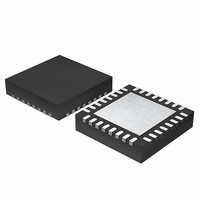EFM32G200F64 Energy Micro, EFM32G200F64 Datasheet - Page 177

EFM32G200F64
Manufacturer Part Number
EFM32G200F64
Description
MCU 32BIT 64KB FLASH 32-QFN
Manufacturer
Energy Micro
Series
Geckor
Datasheets
1.EFM32G200F16.pdf
(63 pages)
2.EFM32G200F16.pdf
(10 pages)
3.EFM32G200F16.pdf
(463 pages)
4.EFM32G200F16.pdf
(136 pages)
Specifications of EFM32G200F64
Core Processor
ARM® Cortex-M3™
Core Size
32-Bit
Speed
32MHz
Connectivity
EBI/EMI, I²C, IrDA, SmartCard, SPI, UART/USART
Peripherals
Brown-out Detect/Reset, DMA, POR, PWM, WDT
Number Of I /o
24
Program Memory Size
64KB (64K x 8)
Program Memory Type
FLASH
Ram Size
16K x 8
Voltage - Supply (vcc/vdd)
1.8 V ~ 3.8 V
Data Converters
A/D 4x12b, D/A 1x12b
Oscillator Type
External
Operating Temperature
-40°C ~ 85°C
Package / Case
32-VQFN Exposed Pad
Processor Series
EFM32G200
Core
ARM Cortex-M3
Data Bus Width
32 bit
Data Ram Size
16 KB
Interface Type
I2C, UART
Maximum Clock Frequency
32 MHz
Number Of Programmable I/os
24
Number Of Timers
2
Operating Supply Voltage
1.8 V to 3.8 V
Maximum Operating Temperature
+ 85 C
Mounting Style
SMD/SMT
Minimum Operating Temperature
- 40 C
Lead Free Status / RoHS Status
Lead free / RoHS Compliant
Eeprom Size
-
Lead Free Status / Rohs Status
Details
Available stocks
Company
Part Number
Manufacturer
Quantity
Price
- EFM32G200F16 PDF datasheet
- EFM32G200F16 PDF datasheet #2
- EFM32G200F16 PDF datasheet #3
- EFM32G200F16 PDF datasheet #4
- Current page: 177 of 463
- Download datasheet (8Mb)
16.3.2 Asynchronous Operation
16.3.2.1 Frame Format
2010-09-06 - d0001_Rev1.00
Asynchronous or synchronous mode can be selected by configuring SYNC in USARTn_CTRL. The
options are listed with supported protocols in Table 16.1 (p. 177) . Full duplex and half duplex
communication is supported in both asynchronous and synchronous mode.
Table 16.1. USART Asynchronous vs. Synchronous Mode
Table 16.2 (p. 177) explains the functionality of the different USART pins when the USART operates
in different modes. Pin functionality enclosed in square brackets is optional, and depends on additional
configuration parameters. LOOPBK and MASTER are discussed in Section 16.3.2.5 (p. 185) and
Section 16.3.3.3 (p. 192) respectively.
Table 16.2. USART Pin Usage
The frame format used in asynchronous mode consists of a set of data bits in addition to bits for
synchronization and optionally a parity bit for error checking. A frame starts with one start-bit (S), where
the line is driven low for one bit-period. This signals the start of a frame, and is used for synchronization.
Following the start bit are 4 to 16 data bits and an optional parity bit. Finally, a number of stop-bits, where
the line is driven high, end the frame. An example frame is shown in Figure 16.2 (p. 177) .
Figure 16.2. USART Asynchronous Frame Format
The number of data bits in a frame is set by DATABITS in USARTn_FRAME, see Table 16.3 (p. 178)
, and the number of stop-bits is set by STOPBITS in USARTn_FRAME, see Table 16.4 (p. 178) .
Whether or not a parity bit should be included, and whether it should be even or odd is defined by
PARITY, also in USARTn_FRAME. For communication to be possible, all parties of an asynchronous
transfer must agree on the frame format being used.
SYNC
0
1
SYNC
0
1
1
1
1
1
Stop or idle
LOOPBK
0
1
0
0
1
1
S
Communication Mode
Asynchronous
Synchronous
0
MASTER
x
x
0
1
0
1
1
2
U(S)n_TX
(MOSI)
Data out
Data out/in
Data in
Data out
Data out/in
Data out/in
3
Supported Protocols
RS-232, RS-485 (w/external driver), IrDA, ISO 7816
SPI, MicroWire, 3-wire
4
...the world's most energy friendly microcontrollers
Fram e
177
[ 5]
U(S)n_RX (MISO)
Data in
-
Data out
Data in
-
-
[ 6]
Pin functionality
[ 7]
USn_CLK
-
-
Clock in
Clock out
Clock in
Clock out
[ 8]
[ P]
www.energymicro.com
Stop
USn_CS
[Driver enable]
[Driver enable]
Slave select
[Auto slave select]
Slave select
[Auto slave select]
Start or idle
Related parts for EFM32G200F64
Image
Part Number
Description
Manufacturer
Datasheet
Request
R

Part Number:
Description:
KIT STARTER EFM32 GECKO
Manufacturer:
Energy Micro
Datasheet:

Part Number:
Description:
KIT DEV EFM32 GECKO LCD SUPPORT
Manufacturer:
Energy Micro
Datasheet:

Part Number:
Description:
BOARD PROTOTYPING FOR EFM32
Manufacturer:
Energy Micro
Datasheet:

Part Number:
Description:
KIT DEVELOPMENT EFM32 GECKO
Manufacturer:
Energy Micro
Datasheet:

Part Number:
Description:
MCU, MPU & DSP Development Tools TG840 Sample Kit
Manufacturer:
Energy Micro
Datasheet:

Part Number:
Description:
MCU, MPU & DSP Development Tools TG Starter Kit
Manufacturer:
Energy Micro
Datasheet:

Part Number:
Description:
MCU, MPU & DSP Development Tools TG108 Sample Kit
Manufacturer:
Energy Micro

Part Number:
Description:
MCU, MPU & DSP Development Tools TG210 Sample Kit
Manufacturer:
Energy Micro
Datasheet:

Part Number:
Description:
MCU, MPU & DSP Development Tools TG822 Sample Kit
Manufacturer:
Energy Micro
Datasheet:

Part Number:
Description:
MCU, MPU & DSP Development Tools TG230 Sample Kit
Manufacturer:
Energy Micro

Part Number:
Description:
SAMPLE KIT (SMALL BOX - CONTAINING 2 DEVICES)
Manufacturer:
Energy Micro

Part Number:
Description:
SAMPLE KIT (SMALL BOX - CONTAINING 2 DEVICES)
Manufacturer:
Energy Micro











